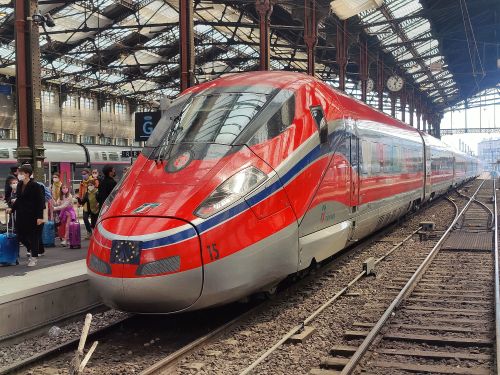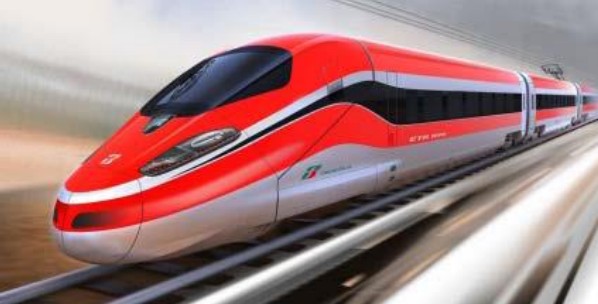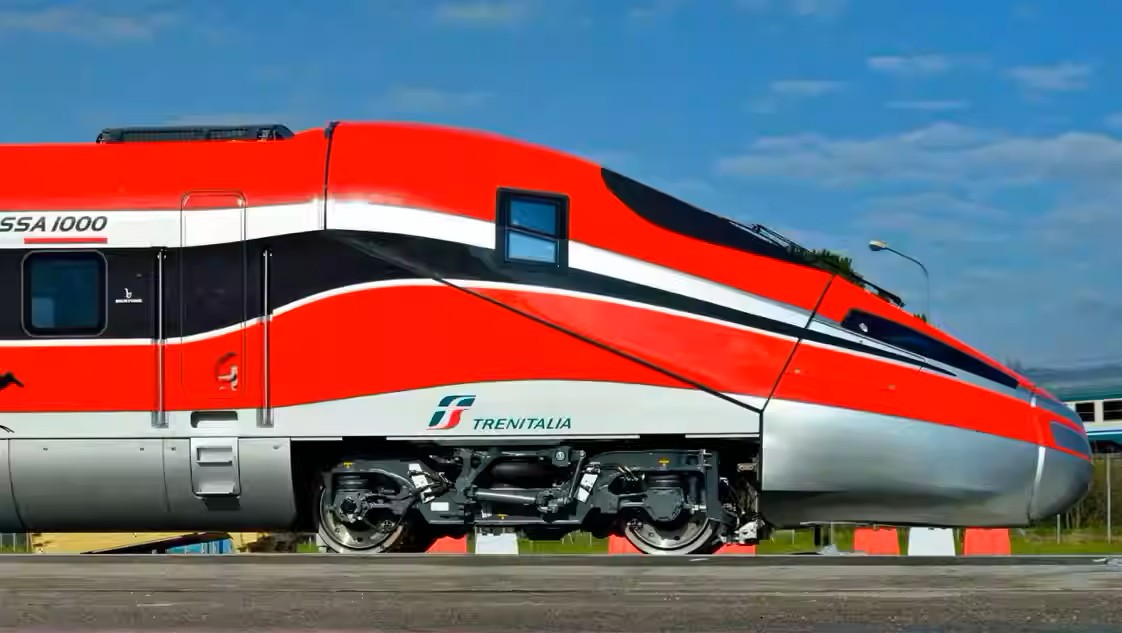Rolling stock • Block train • High speed train • Hitachi Rail • Frecciarossa 1000 (ETR 400)
➤ See also: AGV ETR 575 – Avelia Horizon – ICE 4
Note: For educational purpose only. This page is meant purely as a documentation tool and has no legal effect. It is not a substitute for the official page of the operating company, manufacturer or official institutions. It cannot be used for staff training, which is the responsibility of approved institutions and companies.
In brief
In the mid-2000s, Italy’s Ferrovie dello Stato sought a new very-high-speed train for its Eurostar Alta Velocità Frecciarossa services do not confuse with ‘Eurostar’ between London, Paris and Brussels). In 2008, AnsaldoBreda and Bombardier Transportation partnered to develop a train, centralizing design at Bombardier’s Hennigsdorf plant. The result was the Zefiro 300, a 200-meter, eight-car, single-deck train with distributed traction and a top speed of 350 km/h. Bombardier led concept design and propulsion, while AnsaldoBreda handled industrial design and final assembly. Gruppo Bertone styled the train, emphasizing elegance and speed while meeting safety standards. Revised to reach 400 km/h during testing, the train was proposed for cross-border European operations.
In August 2010, Trenitalia awarded the Bombardier/Ansaldo joint venture a €1.54 billion contract, with Bombardier’s share at €654 million. Their €30.8 million-per-train bid undercut Alstom’s offer. Engineering head Marco Sacchi credited their success to innovative design solutions.
By August 2012, a full-scale Frecciarossa 1000 mock-up was unveiled in Rimini by Prime Minister Mario Monti. The first set, named Pietro Mennea, debuted in March 2013 at Ansaldo-Breda’s Pistoia plant. Extensive testing at speeds of 360 km/h began soon after.
On April 25, 2015, certification was completed, celebrated with an inaugural Milan–Rome journey attended by President Sergio Mattarella and other dignitaries. The fleet has grown to become the refered train for Trenitalia’s national and also international operations.
Family name: ETR1000 – Frecciarossa
Class: ETR400 (Trenitalia), S-109 (iryo)
Manufacturer(s): Hitachi Rail
Train type: Trainsets
Sector: Passengers transport
Type of service: Main line
Operator(s): Trenitalia (80), Trenitalia France (14), iryo (23)
First services: Trenitalia 2015, Trenitalia France 2021, iryo 2022
————————
Train length: 202m
Maximum speed: 360 km/h
Traction system: Water-cooled IGBT–VVVF inverter control
Electric system(s): 25 kV 50 Hz AC, 15 kV 16.7 Hz AC, 1,500 V DC, 3,000 V DC
Pantograph: 8 (2 per power car)
Braking system(s): Dynamic and Regenerative brake
Track gauge: 1,435 mm
————————
Formation: 8 cars (including 4 power cars)
Executive: 10 seats (not on iryo*)
Business: 69 seats (not on iryo*)
Premium: 76 seats (not on iryo*, not in France)
Standard: 300 seats (+2 places for wheelchair) (more on iryo*, more in France)
Restaurant car: no
Bar car: yes
Total seats: 457 seats (not on iryo*)
* See our page for more details about the iryo S-109
The definition of a high-speed train varies by region, but generally, it refers to trains that operate at speeds of at least 250 km/h (155 mph) on newly built lines and 200 km/h (124 mph) on upgraded lines. In Europe, for example, the UIC (International Union of Railways) considers a commercial speed of 250 km/h as the principal criterion for high-speed rail. In the United States, the definition can include trains operating at speeds ranging from 180 km/h (110 mph) to 240 km/h (150 mph).
➤ See the UIC definition
In addition, the european’s TSI gives two high-speed classes (according 2008/232/EC point 4.2.1.1 b) :
• Class 1: trains with a maximum speed of 250 km/h or more;
• Class 2: trains with a maximal speed of at least 190 km/h, but less than 250 km/h.
Ordering
Until 2025, Trenitalia has ordered a total of 117 ETR 1000 Frecciarossa trainsets in three series:
• 1st batch (2013): 50 trainsets
• 2nd batch (2020): 37 trainsets (14 trainsets for Trenitalia France, 23 trainsets for iryo in Spain)
• 3rd batch (2023): 30 trainsets (+10 if option exerciced).
The latter order of 2023, worth €861 million, includes an option for a further 10 trains, which could bring the total to 127 if the option is exercised.
Customers on this train

Trenitalia
2015 – …
3rd batch – ETR 400
Trenitalia
2023 – …

Trenitalia France
2021 – …

iryo
2022 – …
Background and development
It all started with two companies that no longer exist:
• Canada’s Bombardier Transportation, which made a name for itself in Europe with some success in the 2000s (TRAXX locomotives), but decided around 2019 to exit both rail and commercial aviation, to refocus solely on business aircraft;
• Italy’s AnsaldoBreda racked up a series of setbacks in the years 2010-2015 with recurring technical problems on the Danish IC4 and the famous Dutch Fyra, an attempt to make low-cost V250 trains.
These two companies were involved in the construction of the ETR1000 and that’s why we’re talking about it.
Bombardier Transportation, along with its predecessor companies, developed a wide range of (high-speed) trainsets, often in collaboration with other major industrial groups. These projects included the Intercity-Express (ICE) family of locomotives (Germany), the AVE Class 102 and RENFE Class 130 (Spain) and contributions to the TGV Duplex, Eurostar, Thalys, and ETR 500 trainsets across Europe. The ICN trainset (for SBB Switzerland) or the Acela Express (USA), the X 2000 and Regina (Sweden), and the Class 71 (Norway), which are not ‘high speed train’, are also part of contribution from Bombardier.
At the time, Bombardier presented its range of high-speed trains as shown in Figure 1 opposite. Three types of product were available.

The Zefiro concept in China
The real adventure with high speed technology begins when Bombardier independently produced high-speed trains for specific markets, such as the CRH1 ‘Xinshisu‘ (China). It was on the basis of this experience that, Bombardier introduced the Zefiro in November 2005, a flexible, single-deck high-speed train platform. Designed for high-speed rail lines, the Zefiro could be configured in 4-, 8-, 12-, or 16-car sets, adapted to various supply voltages, and built in either a standard width (2.9 meters) or a wide-body format (3.4 meters).
The Zefiro is a conventional, non-articulated, single-deck electric multiple unit (EMU) high-speed train. It features a combination of powered and unpowered vehicles, with motorized power cars positioned at each end. Carbody construction is primarily aluminium, except for the wide-bodied Zefiro 250 variant, which utilizes stainless steel. The interior configuration is modular, allowing for customizable open-plan layouts.
The train is composed of 4-car modules, each equipped with an onboard transformer and independent power supply. Typically, the outer cars of each 4-car set are fitted with powered bogies, while the intermediate cars are unpowered. The pantograph is mounted on one of the unpowered vehicles.
The ‘European’ Zefiro
As the first generation trains cannot operate off 25 kV AC, new trains had to be ordered. As the new trains can run both off 25 kV AC and 3 kV DC, they were designated P for politension (multi-current). As the first request for a high-speed train came from the FS group, and therefore from Italy, it was “logical” to find Bombardier and AnsaldoBreda. Bombardier had established itself in Italy in 2001 when it acquired Daimler-Chrysler Rail Systems Italia, previously known as Tecnomasio Italiano Brown Boveri (TIBB). Following the acquisition, the company was renamed Bombardier Transportation Italy.
AnsaldoBreda was formed in 2001 from the merger of two historic companies: Ansaldo Trasporti (based in Genoa) and Breda Costruzioni Ferroviarie (based in Pistoia). Both Breda and Ansaldo were part of the TREVI consortium that built the first high-speed train: the ETR 500. AnsaldoBreda, even when merged, already had experience in high-speed rail.
In the 1990s, in response to European directives aimed at separating infrastructure management activities (tracks, stations, etc.) from commercial operations (trains, passenger and freight transport), Italy began to reorganise FS.
In 2000, FS became a holding company (Ferrovie dello Stato S.p.A.), and Trenitalia S.p.A. was created as a subsidiary dedicated to rail passenger services.
➤ See our dedicated pages
In 2008, AnsaldoBreda and Bombardier Transportation partnered to develop a train, centralizing design at Bombardier’s Hennigsdorf plant. The result was the Zefiro 300, a 200-meter, eight-car, single-deck train with distributed traction and a top speed of 350 km/h. The model presented here differs from the ETR 500 in that it has no power cars: traction is now distributed under 4 of the 8 cars on the train, as on the Siemens ICE 3 trainset, which was built at the same time.
On this occasion, Trenitalia decided to adopt a new livery, abandoning the green that still characterised the ETR500 for the Italian colours.

The design of the ETR 1000 Frecciarossa was curated by the Bertone design studio, in collaboration with Bombardier and AnsaldoBreda (now Hitachi Rail), with the goal of creating a high-speed train that was not only high-performing but also visually distinctive and harmonious with the Italian landscape. Bertone focused on blending aesthetics with functionality, aiming for an aerodynamic shape that improved the train’s efficiency without compromising the elegance of its exterior profile.
The project began with the need to ensure top performance at speeds up to 400 km/h, with special attention paid to aerodynamic resistance and noise reduction. The train’s long, tapered nose was designed to optimize air penetration while giving the vehicle a strong visual identity. The sharp, flowing lines, combined with a red color scheme with silver and black accents, evoke dynamism and speed, underlining the train’s sporty and technological character.
The interiors were conceived with an automotive-inspired approach, prioritizing ergonomics, material quality, and passenger comfort. Bertone developed a sober, modern environment, with careful use of lighting and finishes to create welcoming, quiet, and functional spaces suitable for both short and long journeys. The layout of seating and services was designed to ensure accessibility and overall passenger well-being.
Interoperability
The ETR1000 is a fully interoperable high-speed train designed in accordance with the Technical Specifications for Interoperability (TSI), which define the mandatory requirements for cross-border operability within the European rail network. The train’s mechanical, electrical, and signalling systems are engineered or pre-configured to interface with up to eight foreign railway infrastructures. Driver’s cabs and technical compartments—such as electrical distribution panels—are constructed using a modular architecture to facilitate integration of country-specific onboard systems through a ‘plug-and-play’ approach.
Additionally, the ETR1000 is compliant with the TSI for Persons with Reduced Mobility (PRM TSI). Carriage number three is equipped with two designated PRM seating positions and a deployable boarding platform, enabling wheelchair access without auxiliary lifting devices. This coach also includes an accessible restroom and a spatial layout that ensures seamless movement for PRM passengers to adjacent service areas, including the onboard bistro.

Aerodynamic

Technical details
The trainsets, still called V300ZEFIRO, were designed for a maximum speed of 400km/h, but in practice for a commercial speed of 360km/h where possible. It is a high speed bidirectional single deck electrical multiple unit (EMU), made up of 8 elements, with the capability of being coupled up to two 8-elements trainsets in order to increase transportation capacity at the same performance of a single train. Four out of the 8 cars are motorized while on the others several electrical and pneumatic equipment are mounted.
Particular attention was paid to the aerodynamics of the trains to save energy and create a very quiet train, generating a minimum of vibrations for the comfort of local residents and passengers. It was de facto made compatible with the TSIs – the Technical Specifications for Interoperability – which were published in 2002 (decision 2002/735/EC of 30 May 2002, published at the end of 2002). According to the consortium, the train was almost 93% recyclable.
Electrical
From the outset, the trainset was designed to run on the four currents and two voltages commonly used in Europe: 1500V DC, 3000V DC, 15kV AC and 25kV AC. In figure 1 are shown the denominations and equipment installed on each element; as clear from the depiction, apart from interior layout, the train configuration is perfectly specular.
• DM1 power and driving car – 4 motor axles;
• TT2 trailer with 2 AC pantographs
• M3 power car – 4 motor axles;
• Two T4 + T5 trailers each with 2 DC pantographs
• M6 power car – 4 motor axles;
• TT7 trailer with 2 DC pantographs
• DM8 power and driving car – 4 motor axles.

The overall traction power, 9.8 MW under 25kv 50Hz catenary and 6.9 MW under 3kV catenary, is provided by 16 asynchronous motors supplied by 4 independant traction systems. Each converter system, which is installed on the same car as motrs, includes in the same chassis both DC and AC devices:8);
• 2 main transfomer (under TT2 and TT7);
• 4M section, with 4 motor converter module (under DM1, M3, M6 and DM8);
• LL section, with 2 line converter modules;
• AC section, with 4 auxiliary converter module and earthing switch (under DM1, M3, M6 and DM8);
• CC section, with 4 chopper converter modules (under DM1, M3, M6 and DM8).
The power developed by the 16 engines of each trainset, i.e. 9800 kilowatts, allows an acceleration of 0.7 m/s², higher than the average for other high-speed trains. This advantage means that the trains can be better integrated into train paths, saving 15 minutes on the timetables of previous generations, mainly on the Milan-Rome route.
The powertrain of each locomotive, suspended under the car body, is made up of :
• 4 motor converters (4M), one for each motor to optimise the operation of each motor and the use of available grip;
• 2 PMCF (Line Converter LL), to transform single-phase alternating current into direct current;
• An air-water cooling unit;
• An auxiliary converter (AE);
• 2 step-down choppers (DC) to reduce the 3 KV line voltage to a level compatible with the motor converters.
The MITRAC 1800 traction motor, rated at 630 kilowatts at 2980 rpm, absorbs 320 amperes at 1404 volts and 100 hertz. It weighs 780 kilos.
Bogies and aerodynamics are one and the same. There were designed both to ensure a high riding comfort (according to EN 12299), low noise and low running resistance. The bogies are specifically designed for high speed applications and include additional measures to improve comfort such as pneumatic secondary suspensions and active lateral suspensions which ensure great stability by actively centring the bodyshell with respect to the bogies entering curves.

Bogies
Bogies and aerodynamics are one and the same. There were designed both to ensure a high riding comfort (according to EN 12299), low noise and low running resistance. The bogies are specifically designed for high speed applications and include additional measures to improve comfort such as pneumatic secondary suspensions and active lateral suspensions which ensure great stability by actively centring the bodyshell with respect to the bogies entering curves.
The V300 Zefiro trainset (ETR400 for Trenitalia) are fitted with FLEXX speed bogies which were manufactured in Italy by a partnership between Bombardier and Ansaldo Breda. These bogies were derived from a design that was originally developed for the Zefiro trains operating in China. However, as the Italian market has different requirements, certain modifications had to be made.
The design of the Italian routes placed additional demands on the suspension system. The requirement to run at 360 km/h on track designed for 300 km/h meant that special measures were needed to achieve a good ride comfort. So these latest bogies feature active lateral suspension which enables them to improve ride comfort while travelling at speed. the bogies had to be designed for minimal maintenance: with the first major overhaul scheduled only after five years, during which time the bogies may have run around 2.5 million km. Trenitalia target indeed to run each trainset with 500.000 kilometres per year.
Second batch for France
Coming soon
Second batch for Spain – S-109
Coming soon. 🟧

[TOP]
Rolling stock • Block train • High speed train • Alstom • Lexical
